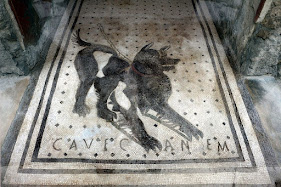But did ancient Jews up to and including the Roman period have household pets? While the evidence is scanty, in this post I will demonstrate that, despite the status of dogs as an unclean animal under Mosaic law, they were definitely held in regard and kept as pets.
Cats and Dogs in the Bible
Cats are mentioned only once in Scripture--in the deuterocanonical book of Baruch 6:21, where the author mocks idols by saying that:
Bats and swallows alight on their bodies and on their heads; and cats as well as birds.
Dogs are mentioned significantly more throughout Hebrew and Christian scriptures. There is a word in Hebrew for a domesticated dog (keleb; כֶּלֶב), distinct from the word for wolf (ze'eb; זְאֵב). The fact that the Arabic cognates for these are the very same word with the predicted phonological differences (kalb; كلب and dhi'b; ذئب respectively) is proof that domesticated dogs had a relationship of some sort with Semitic peoples from very ancient times.
The ritually unclean status of dogs is established in Leviticus 11:27:
Of the various quadrapeds, all those that walk on paws are unclean for you;
everyone who touches their dead bodies shall be unclean until evening.
While at first glance one might assume that such an animal cannot therefore be a pet in the home, note that a person only incurs ritual uncleanness by touching the dead body of one of these. This verse primarily establishes that dogs would not be kosher for eating. Horses are also non-kosher, in that they do not have a split hoof (Leviticus 11:26), but they would have been routinely touched while used for travel and warfare.
Dogs as Pets?
The primary biblical example of a dog as a pet in ancient times comes to us from the deuterocanonical book of Tobit. The son of Tobit, Tobiah, goes on a journey, accompanied unawares by the Archangel Raphael, to recover a large sum of money that his now blinded father had deposited in another city. And we read in Tobit 6:2:
When the boy left home, accompanied by the angel, the dog followed
Tobiah out of the house and went with them.
It is evident from this verse that the family has a pet dog that actually lives in the house.
Later in the book, when, with the help of Raphael, Tobiah has not only gotten the money, met and married the maiden Sarah, and obtained an ointment of gall that will heal his father's blindness, we read in Tobit 11:4:
So they both went on ahead and Raphael said to Tobiah,
"Have the gall in your hand!"
And the dog ran along behind them.
So even though the dog was not mentioned throughout the entirety of the story, we are to know that the dog was always there behind the scenes.
Dogs in the New Testament
That dogs were known to live in homes in the New Testament period is proven by the exchange between Jesus and the Syro-Phoenecian woman in Matthew 15:27. While entreating for a healing for her daughter, and told by Jesus that it was not right to "take the food of the children and throw it to the dogs" (giving a healing to a gentile), she replied, "Please, Lord, even the dogs eat the scraps that fall from the table of their masters (τῶν κυρίων αὐτῶν)." He marvels at her faith and grants her the healing.
No one lets a stray dog just wander into their home and eat food under the table. This text makes it clear that these are animals owned by the people in the house, since they are the dogs' "masters."
God and Man's Best Friend?
Now, one could assert that the story of Tobit, set in Nineveh (modern day Mosul, Iraq) after the exile of the Northern tribes, but likely written during the Hellenistic Period (perhaps 2nd century BCE), does not reflect the mores of Jews regarding dogs in more ancient times.
There is a verse, however, from Isaiah that I feel has been overlooked for its implications regarding the attitude of more ancient Jews toward dogs. In a passage asserting that the old sacrificial system is not as important as obedience, we read in Isaiah 66:2-3, words reported as speech from God:
This is the one whom I approve:
the lowly and afflicted person who trembles at my word.
Slaughtering an ox is like slaying a man
sacrificing a lamb is like breaking the neck of a dog.
Surprisingly , this passage equates the murder of a human and the killing of a dog.
Hebrew poetry is based on parallelism, not rhyme or meter. One line makes a statement. The next echoes it. Another example from Psalm 89:14:
Strong is your hand
Exalted is your right hand
The two parallel statements are equivalent, albeit employing different vocabulary.
Chapter 66 of Isaiah is understood by scholars to have been written in the early post-exilic period (post 539 BCE). It is clear that the culture that produced the above verse considers the indiscriminate killing of a dog to be a senseless and morally reprehensible act on par with the killing of a human.
If the author feels that strongly about the killing of a dog, it would not be unreasonable to believe that, in the world of this author, dogs living as pets in homes is a common and accepted practice.
Conclusion
That dogs were kept as pets in their homes by ancient Jews at least after the exilic period seems abundantly clear. The esteem for dogs implied by the above cited verse from Isaiah is quite remarkable. Despite a dearth of explicit references to dogs as pets in the Bible, in all likelihood, beloved canine companions should be inserted mentally into all of your familiar Bible stories. They were there and cherished as much as they are today, even if the focus of the subject matter only attests them scantily.






No comments:
Post a Comment